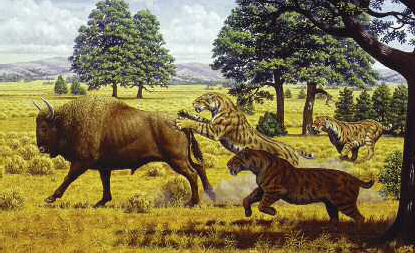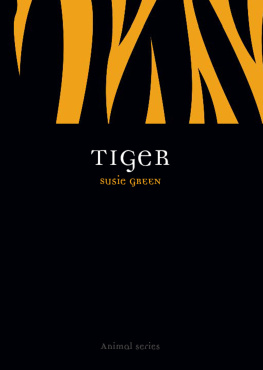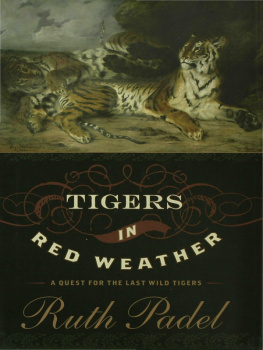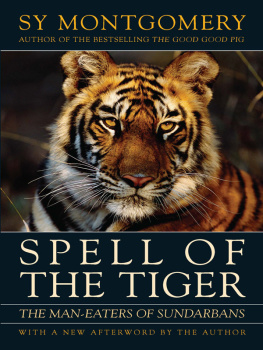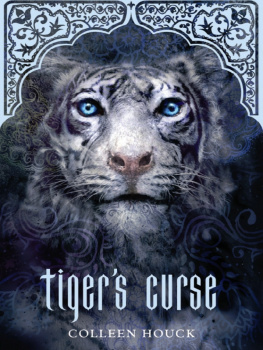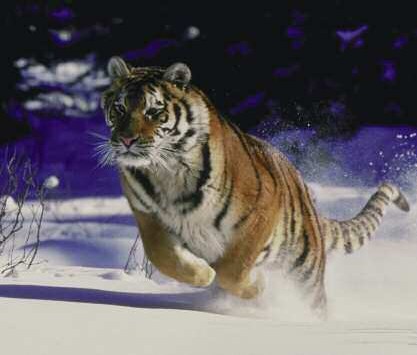Evolution and Natural History
There is no savage beast in the jungle save that which
has been made savage by man.
Patrick Hanley
As the origins of the world are shrouded in mystery so are those of the worlds supreme predator, the tiger. The Naga of northeast India believe that when the earth was young, the ancient scaly pangolin, a wondrous anteater, allowed the mother of the first spirit, the first man and the first tiger to emerge through his deep burrow onto the verdant earth. The tiger went to dwell in the dark, luxuriant forests while his brother, being human, stayed at home. Eventually the man ventured into the forest, where he was forced to fight his tiger brother, whom he tricked into crossing a river, then killed with a poisoned dart. The golden-black striated body floated gently on the rivers currents and finally came to rest in a bed of reeds, where it was discovered by the divine Dingu-Aneni. Realizing the tiger was born of woman and thus mans brother he took the tigers bones from the waters and for ten long years covered them with his warm body until hundreds of tigers sprang from the bones and populated the plains and the forests.
The palaeontologists are not certain of what they believe and are accompanied in their uncertainty by molecular biologists. As one expert in the field, Alan Turner, wrote at the end of the twentieth century, Despite the outline understanding of felid evolution that we now have, it should be stressed that we still lack any clear idea of the immediate ancestry of the living
This, however, is a widely accepted classification:
Kingdom: Animalia
Phylum: Chordata (vertebrates)
Class: Mammalia
Order: Carnivora
Family: Felidae
Sub Family: Machairodontinae, the sabre-toothed cats
with flattened and elongated canines
Sub Family: Felinae or true cats, those with conical canines (all the Panthera)
Genus: Panthera
Species: Panthera tigris (the tiger), Panthera leo (the lion), Panthera pardus (the leopard)
One of the major problems from a palaeontologists point of view is the lack of fossil remains. Carnivores are massively outnumbered by their prey and comprise a mere 2 per cent of the worlds animals. The conditions for fossilization occur rarely, so the chances of felid remains in particular being discovered are extremely rare and the margin for error in tracing lineage large, but despite this, theories, like the carnivores, have evolved.
The general consensus of opinion is that the first creatures we class as Carnivora appeared on the earth during the Palaeocene, some 60 million years ago. These were all-purpose Carnivora, with teeth capable of cracking bones, shearing flesh and grinding. They had claws and could probably climb trees. As the millennia passed, these creatures began to fit into different ecological niches giving rise to more specialized Carnivorauntil, around 30 million years ago, during the Oligocene, the remains of what we would think of as a cat,Proailurtus lemanensis, although with rather more teeth, were deposited in France. Chronologically the next cat, unearthed in New Mexico and California, was a rather puma-like creature, Pseudaelurus, whose skeleton suggests she was a fabulous tree climber.
Many people think Pseudaelurus was the ancestor of both what we think of as modern cats, from a radiation beginning with Pseudaelurus schizailurus around 20 million years ago in the Miocene, and the sabre-toothed cats or machairodonts, of whom there are now no known living examples, from a radiation of the same era.
All modern cats, from tiger to Siamese, posses strong conical canines, ideal for attacking and seizing prey with. This, for many authorities, rules out the sabre-toothed cats as their ancestor as these machairodonts all had extremely long, flat, sheared canines, ideal for slicing through flesh but far too fragile to seize prey with. In short, for many, the sabre-toothed tiger was most certainly not a tiger but there are other, more recent, contenders such as Dinofelis, who padded the earth a mere 5 million years ago. Also known as false sabre-toothed tigers because their canines, although partially flattened, were only the length of those of a contemporary tiger, they ranged through North America, Europe, Africa and Asia until perhaps as recently as ten thousand years ago, dining on antelopes, baboons and australopithecines. Dinofelis abeli was a giant form that inhabited China, bringing to mind the enormous modern tigers of Manchuria. Hemmer, a renowned German zoologist, is of the opinion that Panthera took over Dinofelis ecological niche, and this, combined with recent biomolecular comparisons which reveal the close similarity between the American Smilodon (what most people think of as the classicsabre-toothed tiger), and the modern-day leopard and lion, the other members of the Panthera genus, gives rise to an alternative theory, that the sabre-toothed tiger really is Panthera tigris ancestor after all.
